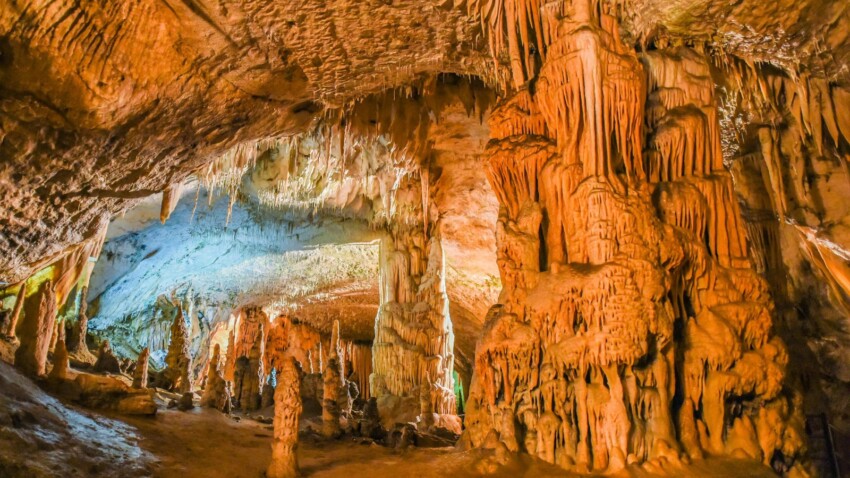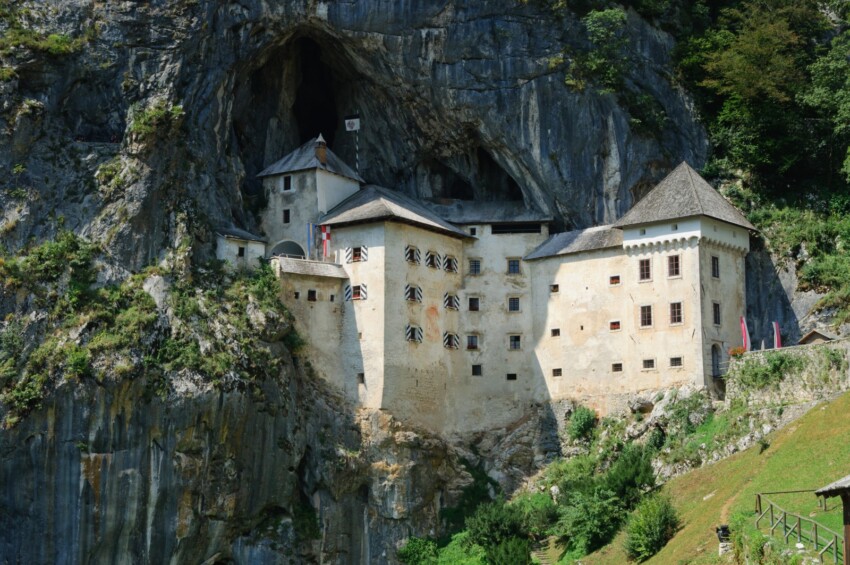
Considered the most visited caves in Europe, the Postojna Cave is one of Slovenia’s most famous sights. If you are planning a road trip to Croatia, the advice is to absolutely stop and visit this beautiful karstic complex in Postojna. These caves were first discovered in 1818 by Luka Čeč, a local who discovered part of the underground area that can still be visited today.
Here, galleries and caverns stretch for around 24 km and are characterised by stalagmites and stalactites, the formation of which occurred due to the flow of water containing calcium carbonate. The oldest form ations seem to have formed 500,000 years ago and the symbol of the caves is a five-metre white stalagmite known as Brilliant. This stalagmite is so called because the water flowing over its surface deposits a thin layer of calcite, giving it its brilliant white colour.
Postojna Cave also enjoys a beautiful record, as it was here in 1872 that the world’s first railway built inside a limestone cave was inaugurated. It is also interesting to know that the caves are still home to the Protei, animals considered to be ‘baby dragons’ that can survive without food for up to 12 years and can live to be 100 years old.

Fascinating and at times mysterious, the Postojna Caves are a must-see on a trip to Slovenia. The caves are located within a park near the town of Postojna, about 50 km from Ljubljana, the capital of Slovenia. In addition to hosting these wonderful limestone formations, this site also features Predjama Castle, a medieval fortress embedded in the rock.
To visit the caves, it is necessary to travel 3.5 km on board a small train that runs along the only underground double-track railway line in the world. The train journey takes you to the start of a 1.5 km long, not at all demanding walk. The route to discover the karst formations is accompanied by a guide who provides all the information and the visit lasts about ninety minutes.
The walking tour starts from the area known as the Big Mountain or Calvary and then crosses the Russian Bridge to the Grotte Belle, so called because of the beauty of the limestone formations here. Next we reach the Brilliant Gallery where the most famous limestone formation in the Caves is located. The tour continues with a visit to the Spaghetti Room, the White Room and the Red Room, ending in the Concert Hall. It is in the latter hall that the Living Crib show is organised during Christmas time.

Just a few kilometres from Postojna Cave is the fascinating Predjama Castle, a complex built on a 123-metre high rock face. Built around the 12th century, the castle has since undergone several extensions and renovations that have given it its current appearance. Inside the fortress you can visit the living area with objects from the period, the knight’s hall, the chapel and the dungeon.
The castle is associated with the figure of the knight Erasmus of Predjama, a local lord who was appointed baron in 1478 by Emperor Frederick III of Habsburg and who took refuge in the castle after his raids. A system of karstic caves is hidden in the back of the fortress, which was used by Erasmus to sneak in and out of the castle and to get supplies in the event of a siege.
Postojna C ave is open daily with guided tours at 10:00 – 12:00 – 15:00.
However, in the summer months the frequency of visits can be intensified.
Visits to Predjama Castle are available daily from 10:00 to 16:00 and are guided by an audio guide.
The cost of entrance tickets to Postojna Cave varies depending on the period.
In the low season (valid from January to mid-June and from September to December) the ticket costs:
In the high season (usually valid in the summer months of June, July, August and during the Christmas holidays)
The cost of admission tickets to Predjama Castle also varies depending on the period of the visit.
In the low season (valid from January to mid-June and from September to December) the ticket costs:
In the high season (usually valid in the summer months of June, July, August and during the Christmas holidays)
It is also possible to purchase combination tickets that allow entry to the Caves and the Castle at a cheaper price.
Tickets can also be purchased online.

The Postojna Caves are easily accessible both by car and by public transport. You first have to drive along the A3 motorway and then along the A1 to exit 41 Postojna. If you are coming from Zagreb, however, you must first take the E70 in the direction of Ljubljana and then continue along the A1 to exit 41.
Postojna can also be reached by public transport, as the town has bus connections with several Slovenian towns. The town also has a railway station just over 2 km from the entrance to the caves. The Postojna railway station is on the Venice-Vienna line and has connections with Zagreb, Salzburg, Rijeka and Koper.
Within the Postojna Cave Park is Hotel Jama, a facility that provides easy access to the caves and all the sites in the park. However, the town of Postojna also has numerous other accommodations both near the centre and outside the town.

Formed millions of years ago and already known in prehistoric times, the Postojna Caves were discovered by chance in 1818 by Luka Čeč, a local inhabitant. In 1919, the caves were opened to the public for tourism, although at the time they could only be discovered on foot. In 1857, on the occasion of the inauguration of the railway between Vienna and Trieste, Emperor Franz Joseph and his wife Elisabeth visited the complex, and for that event, portals were prepared to transport the sovereigns during their visit. The increase in visitors led shortly afterwards to the opening of the first underground railway in a limestone cave, with a line connecting the entrance to the caves to the area of the Great Mountain (or Calvary).
After the Great War, the site became part of the Kingdom of Italy and the railway line was extended to take visitors further into the complex. The train was pulled by a petrol engine that could only carry 20 passengers at a time. Over time, more petrol engines were purchased and used until 1957 when two electric battery engines replaced the petrol engines that were considered obsolete and polluting. As the number of visitors increased, however, the single track was replaced by a circular line, which allowed more and more visitors to be transported more efficiently.
The Postojna Caves are located near the town of Postojna and are about 45 km from Trieste, 50 km from Ljubljana and 190 km from Zagreb.